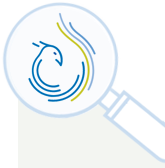The use of plant protection products is always in the focus of public interest. Mostly it is about residues in food and water. But some people will have asked themselves what actually happens to the empty packaging. Can they be recycled without contamination?
Where to put 4,000 tonnes of canisters every year?
Every year, almost 4,000 tonnes of crop protection and liquid fertiliser packaging are put on the market in Germany. They are designed with a great deal of know-how so that the contents can be transported and handled safely if they are handled properly. But what happens when the canisters are emptied? Disposal via the yellow bag would certainly not be the ideal solution. If pesticide packaging with residual quantities were collected in this packaging stream, this could limit the recycling possibilities of the remaining collected material.
That is why, as early as 1996, manufacturers and agricultural traders throughout Germany launched the PAMIRA project. The catchy name stands for German PAckMittel-Rücknahme Agrar [Packaging Recovery Agriculture]. The project managers have been organising nationwide collection campaigns for 25 years now. Users of crop protection products and liquid fertilisers bring their packaging to the collection points, which now number around 400. This gives them the certainty that the canisters will be safely disposed of and recycled. The take-back is free of charge.
How does it work? Farmers and gardeners contribute a part themselves: They must rinse their canisters with water after they have been completely emptied and use the rinse water properly together with the remaining spray liquid. According to the current state of the art, this is done via the field sprayer. If the packaging do not comply with the PAMIRA acceptance requirements, the staff at the collection points will refuse them.
Recycling instead of incineration
Compliance with residual emptying and rinsing is a basic prerequisite for recycling the cans. In the recycling process, the canisters first go into a shredder, then onto a fine mill. Afterwards, the small pieces are thoroughly washed and impurities are separated in a float-sink process. The dissolved residues and impurities contained in the washing water are disposed of by suitable processes.
The plastic pieces are then processed into regranulate, which is finally used to make cable conduits. Recycling is thus possible in this way, which at the same time eliminates hazards for people and the environment.
The recycling solution has a major advantage: in contrast to incineration, less CO2 is produced. According to calculations by the Fraunhofer Institute, the collection campaigns that have been running for 25 years have already saved around 34,500 tonnes of greenhouse gas. This corresponds to the bonding capacity of almost 2.5 million trees.
Non-flushable packaging, such as sacks or folding boxes, which can still contain small residual quantities, is separated at the collection points and goes to energy recovery.
Lowest possible CO2 emissions
In order to reduce the carbon footprint even further, three press containers will be in use at the collection points for the first time in 2021. Like a rubbish truck, the empty packaging is thrown into a flap at the rear end of the closed container and then compacted. As a result, a container can hold about 4 tonnes of packaging - without compaction it is only 1 tonne. The number of transport trips to the recycling sites, diesel consumption and thus CO2 emissions are reduced accordingly.
PAMIRA has a wide acceptance in agriculture and horticulture. Although it works without a deposit, the return rates in recent years have been around 80% of the packaging materials put into circulation. The manufacturing companies organised in the Industrieverband Agrar e. V. (IVA) and the company RIGK GmbH, which is in charge of the implementation, want to increase the high rate as much as possible. Among other things, this will be achieved by optimising the number and spatial distribution of collection points and targeted public relations work via various media and apps. A recently digitalised acceptance process, which speeds up the necessary formalities for farmers, gardeners and staff at the collection points and makes them more convenient, should also contribute to this.
More information:
Thorsten Heil
System Manager PAMIRA
Friedrichstr. 6, D-65185 Wiesbaden
Tel.: +49 (0) 611 308600-17
heil(at)rigk.de; www.pamira.de
Further information can be found at here.
